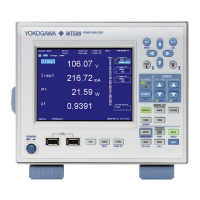App-6
IM 760201-01E
Delta Computation (Optional)
Computed results are determined by substituting all of the sampled data in the table
into the equations for voltage U and current I.
*
The synchronization source used in
delta computation is the same source as the source of the first input element (the input
element with the smallest number) in the wiring unit that is subject to delta computation.
u (t)
u1–u2
u1–u2
u2–u3
u3–u1
– – –
– – –
– – –
– – –
i1+i2+i3
u1–u2
i1–i2
–i1–i2
i (t)
Difference
3P3W→3V3A
Delta→Star
Star→Delta
i1+i2+i3
– – –
– – –
– – –
– – –
– – –
– – –
u1–
3
(u1+u2)
u2–
3
(u1+u2)
–
3
(u1+u2)
∆F1rms[Udiff],
∆F2rms[Idiff]
∆F1rms[Urs],
∆F2rms[It]
∆F1rms[Ur]
∆F2rms[Us]
∆F3rms[Ut]
∆F4rms[In]
∆F1rms[Urs]
∆F2rms[Ust]
∆F3rms[Utr]
∆F4rms[In]
It is assumed
that the center
of the delta
connection
is computed
as the center
of the star
connection.
Phase voltage computed
in a three-phase,
three-wire (3V3A) system
Line voltage computed in
a three-phase, four-wire
system
Neutral phase current
Neutral phase current
Delta
computation
type φ
Σ
[°]
Substituted Sampled Data
Delta functions
Data Determined with the Delta
Computation and Corresponding
Measurement Function Symbols
The computation mode for ∆F1 to ∆F4 can
be set to RMS, MEAN, RMEAN, DC, or AC.
Differential voltage and
differential current
Unmeasured line voltage
and phase current
computed in a three-
phase, three-wire system
Note
It is assumed that
i1 + i2 + i3 = 0
* The equations for voltage U and current I listed in “Symbols and Determination of Measurement
Functions.”
Note
• u1, u2, and u3 represent the sampled voltage data of elements 1, 2, and 3, respectively. i1,
i2, and i3 represent the sampled current data of elements 1, 2, and 3, respectively.
• The numbers (1, 2, 3, and 4) that are attached to delta computation measurement function
symbols have no relation to the element numbers.
• We recommend that you set the measurement range and scaling (conversion ratios and
coefficients) of the elements that are undergoing delta computation as closely as possible.
Using different measurement ranges or scaling causes the measurement resolutions of the
sampled data to be different. This results in errors.
Appendix 1 Symbols and Determination of Measurement Functions

